Most cannabis growers are familiar with the terms ‘mixed-gender’ or ‘hermaphrodite’ plants, what causes them to develop, and how to avoid them in the garden. In this article, we’ll teach you what signs to look out for.
Whether you’re a newbie grower or a seasoned harvester, learning about hermaphrodites and other mixed-gender plants is not only an interesting phenomenon to observe, but an important part of any grower’s knowledge and education. Recognizing the development of potential mixed-gender plants and what causes them will ensure a better harvest.
Nearly all animal species are produced from one male and one female parent—and their offspring can, in turn, produce either gender. Weed seeds are just the same: they are produced by one male and one female parent and are capable of growing into either a male or female plant. It is impossible to determine which plant gender a cannabis seed will produce; however, once a seed enters the ‘flowering stage’ it becomes quite simple to identify its sex after approximately two weeks. Occasionally—and under certain circumstances—a plant will develop traits of both genders, exhibiting male and female characteristics. This is known as hermaphroditism—an undesirable element in any cannabis crop.
Another mixed-gender occurrence is known as ‘bananas’ (or ‘nanners’). Bananas are exposed male pollen sacs (stamen) that begin growing from a female plant that has been exposed to stress. These sacs—normally located on the male plant—are typically encased in a protective layer containing pollen and are not exposed until it is time for them to burst.
Let’s examine the growth stages of cannabis plants more closely in order to understand when, where, why, and how hermaphrodite and mixed-gender plants develop and how to avoid them.
Plant Growth Stages
Seed Stage
The first stage of any future plant is the seed, of course. Cannabis seeds are available in regular, feminized, and auto-flowering types.
Regular seeds are just that: your regular, everyday cannabis plant seeds, capable of producing either male or female plants. Feminized seeds have been developed specifically to eliminate male chromosomes, thus ensuring every plant in your crop will be female. Autoflowering seeds do not require the strict light/dark ratio of hours in order to move from the vegetative stage to the flowering stage. They simply do so with age, and this means that they are usually ready to harvest within 10 weeks of planting and require the shortest flowering time.
Germination Stage
Germination is the first stage of growth for any plant seed and begins once a seed is moistened. Seeds can be soaked between layers of moist paper towels in order to begin the germination process. Germination is characterized by a tiny taproot pushing through the seed hull where two tiny leaves begin to emerge, typically within 2 to 10 days. Once transplanted, this root will affix itself in the soil, eventually pushing its way through the surface to enter the next stage: seedling.
Seedling Stage
After the first pair of tiny leaves emerge and begin receiving light, another set of small leaves begin to develop. These new leaves differ from the first set in that they begin to display the tell-tale characteristics of a cannabis leaf such as shape, finger points, etc. As seedlings grow, more leaves form along the stem.
As the number of leaves along the stem increases, you may need to support your seedlings by gently staking them- they are weak and delicate at this stage. The seedling stage lasts between 1 and 3 weeks— at which point your plant will have 4 to 10 new leaves— and is ready to enter the next stage: vegetative growth.
Vegetative Growth Stage
The vegetative cycle is when expansion takes place. The plant’s growth rate increases so the leaves can produce enough energy to continue to mature into a ‘tree.’ During this time, plants need all the sunlight and nutrients they can get. Their stems become stronger and thicker to support the new leaves and branches that are developing. Then it’s on to the next stage: pre-flowering.
Pre-flowering Stage
This stage takes anywhere from 1 to 5 months, depending on the strain, and can last from 1 day to 2 weeks. During this time, the speed at which plants grow taller will begin to slow, while more branches and nodes develop, filling the plant out. In this stage, a calyx (plant sepals forming a whorl around developing flower buds as a protective layer) will begin to appear where branches meet stems. Plant genders will be revealed in the next stage: flowering.
Flowering Stage
In this stage, plants will steadily become bushier and continue to fill out as they develop flowers. Approximately two weeks into the flowering stage, a plant will clearly reveal its gender. The flowers take anywhere from 4 to 16 weeks to fully develop. During the flowering stage, sacs containing pollen in male plants will burst to fertilize the female plants. It is important to separate male and female plants as soon as their sex becomes apparent—unless, of course, you wish to produce and harvest quantities of cannabis seeds. While the male’s pollen is necessary to fertilize the female flowers, one or two male plants can produce a sufficient amount of pollen for a whole garden of females. Once pollinated, a female plant will focus its energy on producing more seeds instead of producing new flowers (buds), thus defeating the purpose of your crop. Female plants begin to produce seeds once viable pollen is received from a male plant—these seeds take 2 to 16 weeks to grow to full maturity. Plant gender is important because only female cannabis plants produce the desired outcome of any crop: buds.
It is very important to pay close attention to your plants during the flowering stage as this is when the development of hermaphrodite plants and/or bananas is most likely to occur. It is crucial that you observe your plants’ development and avoid any fluctuation in environment or schedule in order to prevent inflicting any sort of stress on them—a primary cause in the development of mixed-gender plants.
Female Flowers and Characteristics
Female cannabis flowers consist of small, green seed pods with two small, white, fuzzy V-shaped hairs sticking out of them, called stigmas. Individual flowers grow to eventually form the dense clusters we know as ‘buds’. Female cannabis plants tend to be shorter and bushier than male plants. Outdoors, females will reveal themselves later than male plants (7 to 21 days), whereas indoor plants of either gender can usually be ‘sexed’ within 7 to 10 days.
Male Flowers and Characteristics
In the early stages of growth, male cannabis flowers develop tiny balls (or sacs) that resemble small bunches of grapes or bananas where pollen forms. The white hairs characteristic of the female plant will be absent. These sacs eventually open to release pollen and fertilize the female plants. Like mixed-gender and hermaphrodite plants, male plants are undesirable to harvest and best eliminated after their sex has been determined, but before their pollen is shed. Male plants tend to be taller and have fewer leaves, looking a bit more straggly compared to females. Males typically begin to flower more readily than females (7 to 14 days) depending on the light cycle.
What Causes Hermaphrodite Plants to Develop?
Plants have a natural survival instinct to ensure successful reproduction and continuation of the species. When growing conditions become harsh, plants recognize the likelihood of endurance is reduced—their survival mechanism is triggered in response. When this occurs, female plants will produce staminate (male) flowers so that they can self-pollinate and ensure survival. By producing seeds without a true male flower, a plant will then produce the flowers of both sexes simultaneously resulting in hermaphroditism. This is an effective way for plants to adapt under the influence of certain environmental stressors by shortening their natural flowering period. Maintaining a steady regimen for your plants is of the utmost importance in discouraging the development of undesirable mixed-gender plants.
What Causes Bananas to Develop?
Another common mixed-gender plant is known as ‘bananas’—these are elongated, yellow pollen sacs that will grow from the centre of the buds on a distressed female plant. These often grow in clusters that resemble a bunch of bananas.
When bananas appear, they don’t necessarily burst in order to spread pollen as a regular pollen sac would. Bananas begin manufacturing pollen immediately and will seed nearby buds even if they are removed quickly after discovery—thus being more difficult to control than actual pollen sacs. If you notice excessive bananas among your crop, it may be best to harvest all plants immediately.
Female plants that are allowed to grow too long past the ideal harvest time will sometimes produce bananas within their buds in an attempt to self-pollinate and create seeds for next year’s crop. This is not quite as destructive to a crop as hermaphroditism, as it occurs only after plants are past the point of optimum harvest.
Main Stressors That Result in Mixed-Gender Plant Development
- Inconsistent Light Schedule: For indoor grows, be sure to keep plant lights on a timer system and avoid changing the schedule if possible. For outdoor plants, be sure to prevent exposure to artificial light after sundown (such as flood lights, street lights, etc.)
- Respect the Dark: During flowering, it is important to make sure your plants receive a minimum of 12 hours of uninterrupted darkness each night (with the exception of auto-flowering strains). During this ‘dark period’ your plant is awaiting the return of sunlight; interrupting this process is a common stressor to plants and may even cause them to revert back to the vegetative stage. Equally important is the avoidance of light leaks!
- Light Burn: While generally more light is better for cannabis plants, very bright or hot lights (such as high-powered LEDS) can cause ‘light burn.’ This will stress your plants, cause bleaching, and possibly trigger hermie cannabis plants to develop. If your lights are too hot for your hands, then they’re too hot for your plants!
- Temperature: Be sure to maintain an even, comfortable temperature for your plants during the flowering stage—typically 18 to 29 degrees Celsius (65 to 85 degrees Fahrenheit) during the day, with slightly cooler temperatures at night.
- Genetics: Stress can play a major role in the development of both hermies and bananas—although genetics seems to affect the development of bananas more so. Growing seeds that were produced from a plant exhibiting hermie or banana traits are far more likely to produce the same traits as the parent plant.
- General Plant Health: Nutritional deficiencies, root rot, unbalanced soil pH, plant injury, etc. are all important factors that have the potential to trigger the development of mixed-gender weed plants.
It is highly recommended that any plants be removed immediately that exhibit signs of hermaphroditism and/or development of bananas. Remember, if pollen is permitted to contact your buds, your plant will focus all efforts on the development of new seeds and not more buds. And if a plant is allowed to self-pollinate, you will inevitably produce a crop of hermies and bananas – or hermies with bananas. Yikes!
Among mixed-gender cannabis plants, bananas seem to be the least predictable, as they are most likely to cause unwanted pollination since they begin pollinating nearby plant buds immediately without requiring the pollen sac burst.
Attempting to salvage plants that are producing multiple bananas or displaying signs of hermaphroditism is not recommended. Not only is it very difficult to ensure you’ve gotten rid of all of them (leaving you with an unwanted crop of seeds), once a plant begins self-pollinating, producing both gender characteristics or producing unwanted bananas, it is nearly impossible to stop the process of Mother Nature. May all your harvests be seed-free!





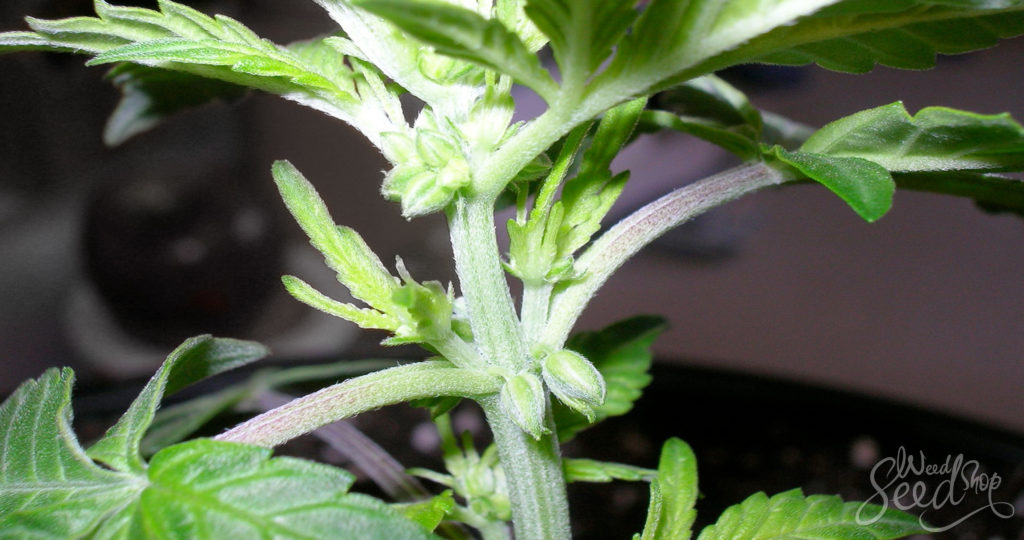

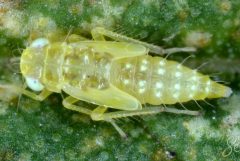
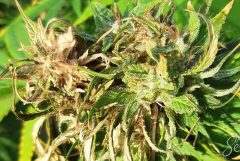

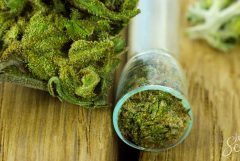

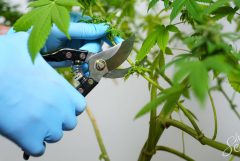

I loved your explanation about hermi plants. I just started growing outdoors last spring. I live in Mexico.
I got weed and it had seeds so I planted them. I knew nothing and produced hermis. I finally got bud from I plant and it was amazing, maybe the best I’ve ever had and I used to have a card in the US.
I have a female plant now who produced 1 banana. I removed it and now she’s beautiful. I’m wondering if transplanting caused it and if she will produce good bud. I only have 2 plants so I hate to loose any.
Thanks for your help
It can and will screw up a crop almost overnight light’s came on temp. soared to 100 degree’s for some hours before I caught it !! Timer went bad it has 3 of 5 turning herm no bananas LOL the 3 were my hope of high grade meds but hey , my first rodeo still , right ? Folks ,I had a perfect grow going too ! Heavy buds covered in tric’s, I’m sick over it ! I was 2 wk’s away SHIT THE BED
I feel for you bro! Nor Cal got decimated with 4 days of over 100*. 56 hrs of no sunlight, heavy particulate and ash covered all my crop! I covered the plants and there was no UV anyway so I wanted to protect them from ash! Within 25 hrs. I have fn Naner trees! Plus I manicured to hard! The perfect storm! I’m fudged!
I’ve been growing a very long time and lately have had some issues. My last to crops have turned on me and are growing numerous banana leaves. I have extremely sterile rooms and use the TLO method, which means I make my own soil and don’t use any chemicals. I don’t have light leaks and have nice filters and mini-splits installed. Other than light, incecticide, and extreme temperature change what can cause this? As a seasoned grower I am so perplexed because I’ve grown for years without this occurring.
Thanks,
Tina
If your seed displays mild ‘nannas’ and seeding due to stress, (as it foxtailed/mild re-veg as well) will clones taken grow desirably if environmental conditions are strictly adhered to?
AH TOOl fan! I FORGOT MY PEN…
Curious? If I have a hermie pollinate a female, does the existing female become a crossbreed or is it just the seeds that will produce crossbreeds??